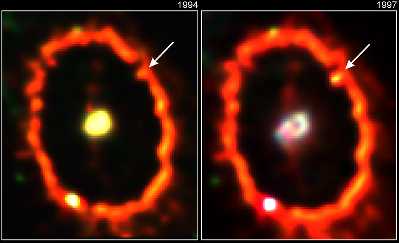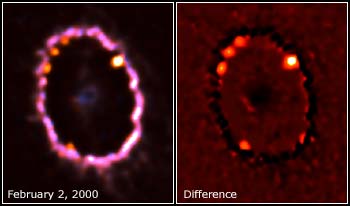
| Bad Astronomy |
|
|
|
BA Blog
|
|
Q & BA
|
|
Bulletin Board
|
| Media |
|
|
|
Bitesize Astronomy
|
|
Bad Astro Store
|
|
Mad Science
|
|
Fun Stuff
|
| Site Info |
|
|
|
Links
|
| RELATED SITES |
| - Universe Today |
| - APOD |
| - The Nine Planets |
| - Mystery Investigators |
| - Slacker Astronomy |
| - Skepticality |
Buy My Stuff

Keep Bad Astronomy close to your heart, and help make me
filthy rich. Hey, it's either this or one of those really
irritating PayPal donation buttons here.
Supernova 1987A: First Contact
Week of March 20, 2000
Last week, I talked about the inner ring around Supernova 1987A, and a little bit about what we learned about it from early Hubble observations. After I got my PhD I wound up working with STIS, a camera aboard Hubble. One of the earliest targets for STIS after launch was, of course SN87A.
What did we find? Well, let's take a look at the ring for a moment. Remember, the rings were formed long before Sanduleak -69 202 blew up and became Supernova 1987A. When it did blow up, the flash of light lit up the ring. That's how we found it.
But wait! A supernova does more than give off light. The explosion itself sends the outer layers of a very large star screaming outwards at a pretty good fraction of the speed of light. Get the picture? The ring is a sitting duck: it's just hanging there, waiting for several solar masses of gas to slam into it at a thousand kilometers per second!
No one knows exactly when the bulk of the supernova debris will hit the ring. Most prediction say 2003 - 2010 or so. The reason we're not sure is because we don't know how much material there is between the supernova and the ring. The blue supergiant wind cleared out the dense gas from that region as it expanded, in much the same way that a snow shovel piles up snow in front of it. But the blue supergiant wind was still blowing when the star blew up, so there is still some gas that the debris is slamming into. That slows it down, making ring collision predictions difficult.
 The first hint that something new was happening came in 1998, when
new Hubble images showed that a spot on the ring appeared to be
brightening, and not fading like the rest of the ring. Excitement
grew: was this the first alert that the ring was getting hit by
debris? It seemed too early, but the models could be wrong. So
much was still unknown about the ring! [In the image above, the
blob is in the upper right part of the ring. The bright spot in
the lower left part is
Plait's star.]
The first hint that something new was happening came in 1998, when
new Hubble images showed that a spot on the ring appeared to be
brightening, and not fading like the rest of the ring. Excitement
grew: was this the first alert that the ring was getting hit by
debris? It seemed too early, but the models could be wrong. So
much was still unknown about the ring! [In the image above, the
blob is in the upper right part of the ring. The bright spot in
the lower left part is
Plait's star.]
Then we focused STIS on the ring. The ``hot spot'', as it was called, was clearly shown to be a part of the ring getting hit by fast moving supernova ejecta. We were overjoyed! The best show in the Galaxy, and we had front row seats!
Then reality set in. We waited, and waited, but the spot was never joined by any others. If the fastest moving debris had finally hit the ring, we'd expect to see more of the ring get hit! But the spot stubbornly stayed alone.
 That is, until February of 2000. New images taken by the
SINS
team showed a handful of new "hotspots" on the ring. They
appear to cluster in the southeastern part of the ring, and
interestingly all appear to be slightly more toward the center of the
ring then the ring itself. This makes sense: it means they are closer
to the explosion, and were more likely to get hit early.
Since the whole ring is not lighting up as a unit, we suspect that the
supernova explosion may have sent out fast moving blobs of gas, like
bullets, and some of these are hitting the ring before the main
wave of the debris. In the image, the ring can be seen in the
left half, and the right half shows the change in the ring over time.
The blobs are obvious. You can also see
an animation of the blobs getting brighter.
That is, until February of 2000. New images taken by the
SINS
team showed a handful of new "hotspots" on the ring. They
appear to cluster in the southeastern part of the ring, and
interestingly all appear to be slightly more toward the center of the
ring then the ring itself. This makes sense: it means they are closer
to the explosion, and were more likely to get hit early.
Since the whole ring is not lighting up as a unit, we suspect that the
supernova explosion may have sent out fast moving blobs of gas, like
bullets, and some of these are hitting the ring before the main
wave of the debris. In the image, the ring can be seen in the
left half, and the right half shows the change in the ring over time.
The blobs are obvious. You can also see
an animation of the blobs getting brighter.
One way or another, we still have a great seat to a titanic event, and the ability to get something we rarely see in astronomy: a second chance. As the debris hits the ring, it will light up once again, and we will once again see the ring in all its glory. This time our instruments are more sensitive, and we may finally get the data we need to understand this weird and enigmatic structure.
Next week: a historical timeline of the life of SN87A.
|
|
| THE PANTRY: ARCHIVE OF BITESIZE SNACKS |
|
|
| Subscribe to the Bad Astronomy Newsletter! |
| Talk about Bad Astronomy on the BA Bulletin Board! |